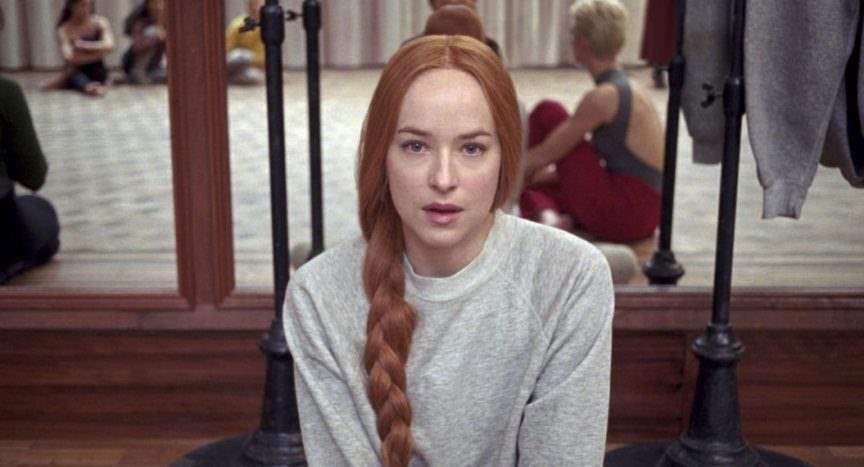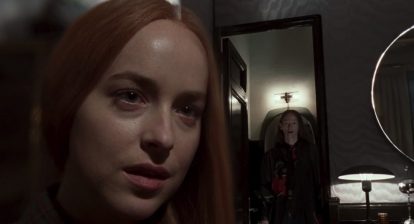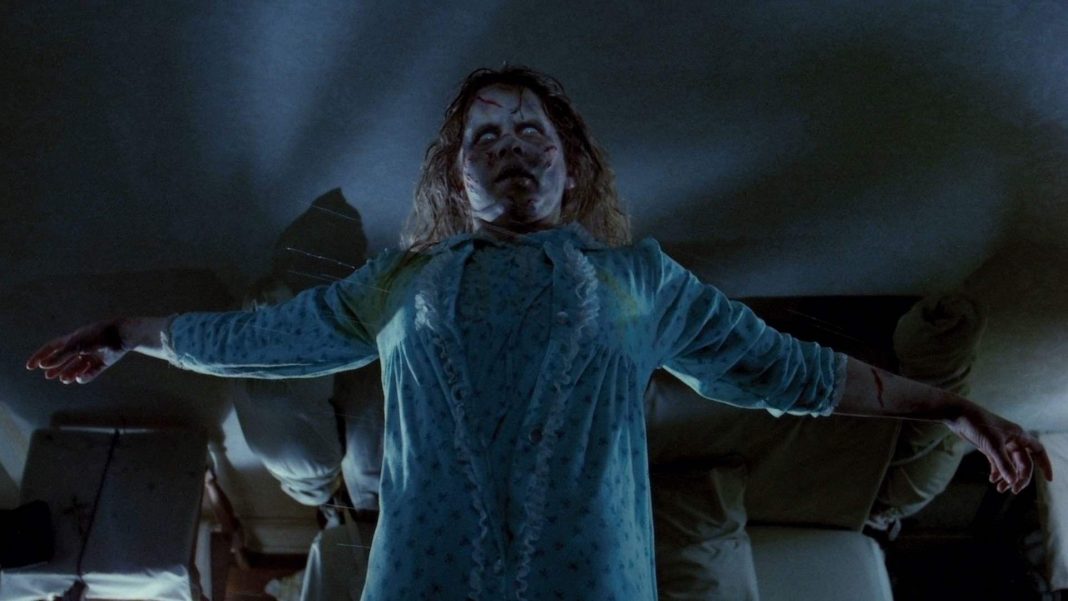Suspiria (2018) has barely cycled through twenty minutes of screen-time when Chloe Grace Moretz (woefully underutilized) refers to her downstairs as a “c*nt.” It’s the first of many noticeably terrible lines (another finds poor Dakota Johnson tasked with telling Tilda Swinton that performing her dreadful modern dance feels “like what it must feel like to fuck” — without cracking up) that could only have been written by a man who thinks women speak, well, like men. Uncouth men, at that.
Dario Argento’s 1977 movie, rightfully lauded all these years later though definitely not without its flaws, is an intensely female movie. It’s fever dream and fantasy, its blood spilling out in garish redness. This is thanks, in no small part, to the screenplay, co-written by the actress and writer Daria Nicolodi. Although Argento bathes the screen in plenty of feminine colours, that feeling of femininity is courtesy of Nicolodi. She understands women, and the predominantly female characters behave accordingly.
Luca Guadagnino, in comparison, is working from a script by another man, David Kajganich (who was also responsible for his 2015 flick, A Bigger Splash, which had similar problems differentiating between “strong female character” and “female character who gets naked a lot/acts a bit mad”). Together, they envision a dull, drab, nightmare version of Berlin where nothing good ever happens and nobody is even the slightest bit interesting. But it’s okay because…there are women?
Johnson’s Susie Bannion arrives to try out for the horrifying academy run by Swinton and her fellow crow-like crones, all of whom loom over their charges like predators surveying their prey. There’s no subtlety at play here. The moment we glimpse the academy, it’s very clear that something isn’t right about it. Even without Moretz’s character’s exposition dump, right off the bat, about the school being run by witches, one could probably guess the place ain’t right.
Suspira (2018) posits itself as being a women’s story about women (it’s so female that Swinton plays the only male character! Distractingly badly!) but only the (male) therapist is given any agency, or even anything resembling a backstory, or motivation. Susie is a cypher right up until the end, when her big reveal is such an about-turn it somehow simultaneously gives you whiplash and reads as utterly predictable. Swinton’s Madame Blanc, meanwhile, mostly just purses her lips. A film claiming to be feminist wasting two brilliant actresses? Sacrilege.
Related: Ten Things You Probably Didn’t Know About the Dario Argento Original

The rest of the girls in the group, and indeed members of the coven, are completely interchangeable. Even Susie’s closest friend, played by the very fine English actress Mia Goth (so fantastic in A Cure For Wellness and Marrowbone), barely registers as anything other than “frightened woman endlessly searching for her friend.” Her fate at the hands of the witches is shot in near-darkness, too, so it’s not even clear what gruesomeness befalls her. There’s no impact, nothing.
Much of Suspiria (2018) is lit so badly it must be a stylistic choice, but the precise reasoning behind it remains unclear. It’s not enough that Argento’s gloriously technicolour pallette has been tossed out, but Guadgnino chooses to replace it with the most drab, bland, and downright beige cinematography so that everybody constantly looks like they’re about to teleport to 1950s Liverpool. The rooms have many dark corners, but nothing is ever lurking besides more beige.
When the horrors do unfold — as in two standout sequences, and two alone — the film momentarily sparks to life. The first, which occurs early on, seems to signal that Guadagnino is finally ready to get this thing going but, once it’s over, he reverts back to characters standing around explaining the plot to each other and crash zooms that come off as silly rather than intense. The second big moment, the Grand Guignol finale, is not nearly as disturbing as intended and, as with everything else, lasts much too long.
It takes a confident man (and rest assured, no woman would ever even make it through the door) to look at a 90-minute movie and decide to add another hour and change onto it, because he has so much more to say. That Guadagnino does so while adding absolutely nothing of value is galling.
The tacked-on political edge, with all its talk of Baader-Meinhof and Nazism, right there in the foreground, overstating its existence like everything else in the blasted thing, adds nothing but time. What’s the point of putting graffiti and news reports in the background, while also having characters actually discuss the issues at play, at length, in the foreground, if none of it has any bearing on the story being told? Suspiria (2018)’s co-opting of these sad events feels cheap and exploitative.

Argento’s Suspiria is notable for many reasons, but it stood out immediately thanks to its score and that colour palette. Guadagnino’s reboot fails on both counts, neither updating nor paying homage to what came before. Aside from its boring look, the score by Thom Yorke (his first, following in band-mate Jonny Greenwood’s footsteps) is so ill-fitting it’s almost comical. A dull, listless, and achingly indie concoction that wouldn’t be out of place in Garden State, it’s often insufferable.
It’s not just Yorke’s strangled whining that grates (it sounds like the newer, bad Radiohead stuff), but the fact that his score doesn’t fit at all with what’s happening onscreen. It would be bizarre if it wasn’t so uninspired. Obviously, the mighty Goblin were never going to be bettered, but Yorke seems to be scoring an entirely different film. His arrangements interrupt moments both insignificant and crucial, never adding anything but distraction.
Suspiria (2018) is filled with its own self-importance, from its Berlin setting to its body horrors, faux feminist spin, and its many, many, many speeches about how deep and meaningful it is. A film this confident should have something interesting to say, but Guadagnino’s take is empty, void of all feeling, much like its blank slate protagonist. When Jessica Harper shows up, one almost feels sorry for her.
The film has been heralded in many quarters as a modern masterpiece, but given the wonderful year we’ve had, it pales in comparison to everything from Hereditary to A Quiet Place. Even compared to the recent resurgence of witch movies it falls flat, whether it’s Robert Eggers mighty The Witch or Rob Zombie’s under-appreciated Lords of Salem. Suspiria (2018) didn’t even necessarily need to be about witches. It could have been about any kind of demonic force and the results would be much the same.
A witch movie that isn’t actually a witch movie is an abomination, but one claiming to put a modern spin on a beloved piece of art that actually adds nothing of value, and provides no comment on how such a work might fit into the 2018 zeitgeist, as opposed to 1977, is unforgivable. And in a year that’s given us a great Halloween sequel, no less. In the grand tradition of terrible remakes, Suspiria (2018) is another that has no reason to exist. Getting through it is a real chore — a charge that could never be levelled at Argento’s wild original.
Related: For a Profoundly Different Take on the Film, See Justin Steele’s Original Review






